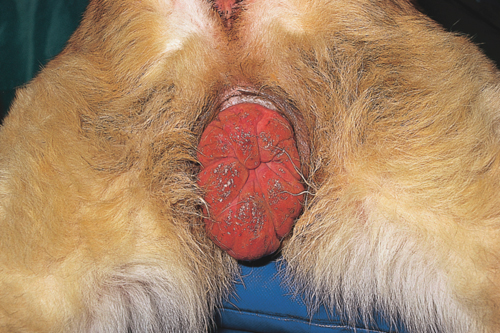Small Animal Abdominal and Metabolic Disorders Q&A 03
| This question was provided by Manson Publishing as part of the OVAL Project. See more Small Animal Abdominal and Metabolic Disorders Q&A. |
A four-year-old, female German Shepherd Dog is presented with a large swelling protruding from the vulval lips. The bitch commenced proestrus ten days previously and presently has a serosanginous discharge and is attractive to male dogs.
| Question | Answer | Article | |
| What are the differential diagnoses? | Vaginal hyperplasia protruding through the vulval lips. Other differential diagnoses include protrusion of a vaginal tumour or polyp and vaginal/uterine prolapse. The latter is very rare and usually only occurs post partum. Palpation of the protruding tissue demonstrates that it originates from the vaginal wall cranial to the external urethral orifice, involving the whole circumference of the vagina rather than the ventral vaginal floor. Vaginal hyperplasia occurs almost solely during proestrus and oestrus and often recurs cyclically. |
[[|Link to Article]] | |
| What is the aetiology of this condition? | Hyperplasia of the vaginal mucosa occurs in response to elevation of plasma oestrogen concentration. The hyperplastic tissue develops from the vaginal floor cranial to the urethral orifice, but as the condition progresses (and often worsens) the tissue may involve the circumference of the vagina. The increase in size causes it to protrude through the vulval lips. |
[[|Link to Article]] | |
| What will happen if this condition is untreated? | In all cases the hyperplastic vaginal mucosa regresses at the onset of metoestrus when oestrogen concentrations decrease and progesterone concentrations increase. Provided that the tissue is not traumatized and does not desiccate, it will return to normal within a few weeks. Bitches that become pregnant do not have difficulty at parturition since the hyperplastic tissue is not present at this time. |
[[|Link to Article]] | |
| What treatment options are available? | In the majority of cases only conservative treatment is warranted and the application of emollient creams and the prevention of self-trauma is sufficient. If the tissue is traumatized or the animal is required for breeding, a submucosal resection via an episiotomy may be necessary. Surgery can be avoided by the use of artificial insemination where allowed. Serious consideration should be given to not breeding from affected animals. |
[[|Link to Article]] | |
